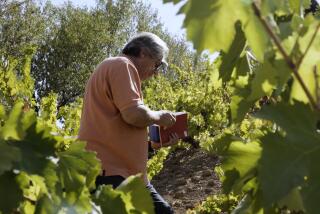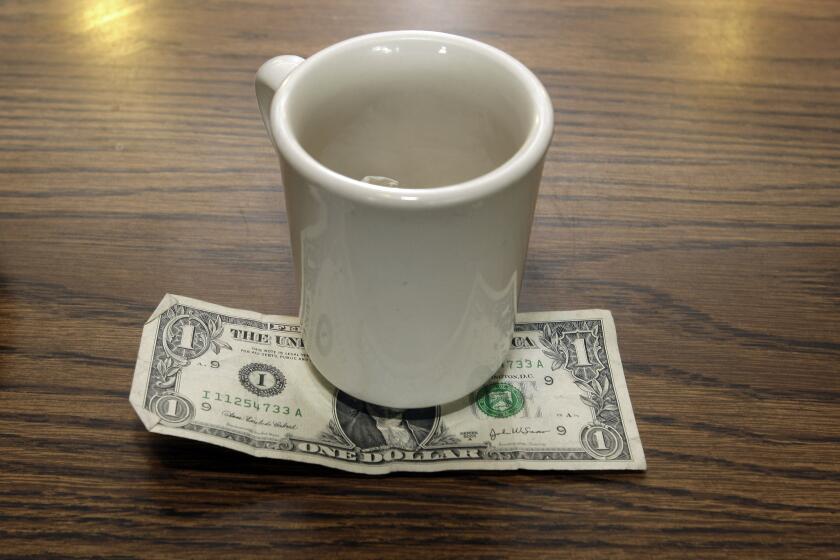VINEGAR : SOUR TALK : THE GOOD STUFF ISN’T JUST SOUR GRAPES. IT’S AN ESSENTIAL FOR GREAT COOKS WHO KNOW THAT THE’S MORE TO VINEGAR THAN VINAIGRETTE. : MOTHER NURTURE
- Share via
Imagine for a moment a Spanish dish such as gambas en vinagreta azafranada , shrimp in a saffron vinaigrette.
Imagine buying two pounds of large, expensive shrimp, then increasing their value even more (depending on what your time is worth) by peeling and deveining, and lightly cooking them. With the shrimp in a bowl you add a teaspoon of salt, a quarter teaspoon of freshly ground black pepper, two hard-boiled eggs, one finely chopped onion, a quarter teaspoon of powdered saffron, a quarter cup of dry Sherry, a half cup of olive oil and a quarter cup of wine vinegar. When you serve the shrimp, chilled, your guests will probably cheer your presence of mind and creative instincts, so delicious are the results.
No doubt you selected French sea salt over table salt, and used the best possible olive oil you could find and afford. So much attention has been given olive oil of late that cooks have come to note the differences between one brand and another in much the same way oenophiles explore wine. But what about the vinegar?
Until recently I had never taken the time to taste the differences that exist between one wine vinegar and another, particularly the ones found on every supermarket shelf and those more likely to be stocked in a specialty shop. I always bought my red wine vinegar at the supermarket, choosing a bottle I have probably reached for ever since cruising the market aisles in my mother’s shopping cart.
*
There’s a bottle on my cupboard shelf right now. I tasted it the other day next to a sample of Badia a Coltibuono red wine vinegar made by the De Medici family in Italy, a vinegar that has been aged three years in oak, is bottled with a 7.5% acidity level and costs about twice as much as the more familiar brand. The inexpensive vinegar has a 5% acidity level, is cut with water and includes sodium metabisulfite as a preservative. I also had a sample of my own homemade vinegar, which, at several months, is almost too young to count.
The Italian vinegar had a lovely color in the dish, like sumac turning toward fall. The commercial vinegar looked like red Easter egg dye. My own vinegar mimicked the Italian brand, though the color had a much more youthful blush. The Italian vinegar had fruity qualities, a gentleness on the tongue, and failed to burn the back of the throat. While my vinegar was more raw and tended to jolt the mouth, it too had a surprising, compelling fruitiness. The cheaper vinegar tasted like something flushed out of a nuclear cooling tower. Hours later I could still feel it in my throat.
*
The Italian vinegar may have won the taste test, but I was happy to discover that my own didn’t fare badly at all. I started making my own vinegar awhile back in a two-gallon crock with a spigot at the bottom. There are two basic ways to proceed.
One is to replace with wine the vinegar you withdraw from the crock, keeping it ever full. The other is to give the vinegar the 10 months it needs to fulfill its potential, then draw it off into bottles that you cork and store in a dark, cool place to allow for an aging process. I haven’t gotten as far as the aging process, and I have to admit at this point that I am taking Richard Olney at his word on the subject. So far he appears to be on to something.
In “Simple French Food” (Atheneum) Olney says of the red wine vinegar he makes and stores that it “takes on a life of its own, its aromas expanding, aggressivity succumbing to nuance with age; the difference between a freshly drawn vinegar and one that has two or three years of bottle age is quite astounding--and perhaps even more marked with specially prepared vinegars into which other flavors have been suffused.”
How could I resist?
I doubt I will ever make a fine wine, but a vinegar of distinction, I believe, is not beyond my all too limited grasp. The process is relatively simple. Just as certain yeasts and bacterium convert the sugar in grape juice to alcohol, hence wine, others are waiting anxiously to convert the alcohol in wine to acetic acid, or vinegar. Louis Pasteur discovered as much in 1864. It is the winemaker’s task to encourage the one fermentation while denying access to the other, mostly by eliminating air. As Pasteur revealed, acetobacter bacteria, the agent of vinegar production, thrive in the presence of air as well as the bath of alcohol. Wine left open to air will eventually form a gossamer white veil on its surface, the fleur blanche so beloved of vinegar-makers, so reviled by winemakers.
Given time, alcohol, air and a comfortable temperature, the fleur blanche will grow into a thick, limacine, floating mass within which the alcohol-to-acetic-acid conversion takes place. The mass is called the mother of the vinegar, and like all mothers is treated by vinegar-makers with respect, and just a touch of superstition.
It was once a common thing, particularly in France, to borrow a piece of mother of vinegar from a neighbor who produced vinegar of note, then start a vinegar culture of one’s own. The vinaigrier , whether crock or cask, was an everyday part of the kitchen. But as soon as Pasteur discovered that aeration encouraged vinegar bacteria, tinkerers got busy and came up with new ways of making vinegar that eliminated the mother of vinegar altogether.
She was too slow to turn an equitable profit in the face of the Industrial Revolution. In the intervening years we have handed over the responsibility for making vinegar to giant, unseen factories. Worse still, we have come to take the commercial vinegar producers’ word that their product is what vinegar should taste like. But once you taste the difference, it is difficult to turn back. And once you realize how simple it is to produce superb vinegar, it seems silly not to do it at home.
*
No great skills are demanded for success beyond an ability to begin the process with everything as clean and sterile as possible. Two-gallon ceramic crocks open at the top with a spigot at the bottom are not that difficult to find. There was a time (and for all I know it still exists) when bottled water was dumped into crocks a bit larger than this. A beer and wine making supplier should have in stock vinegar bacteria culture.
I began my vinegar culture with six bottles of red wine from the remains of a case I had grown to despise, two bottles of water and one bottle of a classy red wine vinegar, as well as the contents of the small jar of vinegar bacteria culture. I covered the top of the crock with cheesecloth to keep out insects and dust while also encouraging aeration. A Palm Springs-like atmosphere, 80 to 90 degrees, helps the vinegar bacteria to rapidly increase and colonize the contents of the crock with a fleur blanche. At lower temperatures the process limps along at a much slower pace, which is all well and good, but if the acetobacter grow too slowly other less endearing strains of yeast or bacteria might establish a stronger colony and take the crock and its contents on an undesirable detour.
The appropriate temperature is achieved by placing the crock in a large cardboard box in which hangs a 30-watt light bulb. Turn on the light and the temperature inside the box will rise to the appropriate range. Once the mother established herself, I put the crock on a shelf in the kitchen, where it sits to this day, mothering away. The vinegar that has come to a youthful maturity, once removed, is simply replaced with wine, and the mother takes it from there.
But here is the lovely part, the part that should appeal to the spendthrift in us all: During the 10 months that his vinegar has been fermenting, Olney has been saving wine most of us would throw away, wine that has oxidized in open bottles, glasses of wine his guests left untouched at the dinner table, dregs of wine filtered off the lees in the bottom of aged bottles. He adds this accumulated wine to empty bottles, corking them one by one as they fill, and saves them against the day, months hence, when he refills his empty vinaigrier .
*
He will, by then, have filled wine bottles with vinegar that he corks, labels and lays down in a dark, cool place. Beyond this I can’t report much more about making vinegar. My experience is much too thin, too young. I need “two or three years of bottle” to speak on the subject with the baritone of authority. But I can say this much: With little effort I feel much closer to the way food was meant to taste before industrial processing seized the day. When I started making my own wine vinegar I joined in a contemporary union with a culinary tradition stretching back to Roman times. Opportunities like that are few in an urban kitchen. Like all good things, this one is so simple.
More to Read
Eat your way across L.A.
Get our weekly Tasting Notes newsletter for reviews, news and more.
You may occasionally receive promotional content from the Los Angeles Times.










